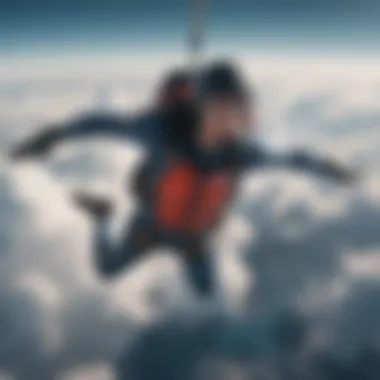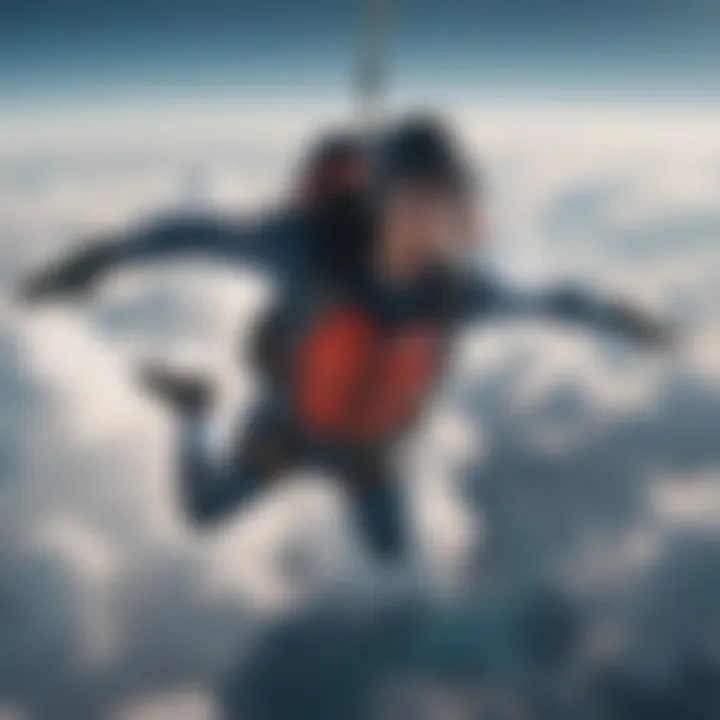Exploring Extreme Sports: Techniques, Gear & Culture


Intro
Extreme sports have captured the attention of many, resonating with thrill-seekers and adventure enthusiasts alike. These activities push physical and mental boundaries, presenting unique challenges that require skill, precision, and determination. From paragliding over stunning landscapes to navigating treacherous rock faces while climbing, the allure of extreme sports is difficult to dismiss.
This article serves as a comprehensive guide, detailing various aspects of extreme sports including techniques, essential gear, safety measures, and spotlighting featured sports and athletes. The aim is to engage both seasoned athletes and newcomers, providing valuable insights that enhance knowledge and appreciation of these adrenaline-driven pursuits.
Each section delivers intricate details focused on skill development, practical techniques, and critical safety measures that can often make the difference between success and failure in extreme sports. Furthermore, understanding the gear needed and available innovations can significantly enhance performance and safety during participation.
As we delve deeper, we will explore not just the how-tos, but also the cultural significance intertwined with these sports, fostering a vibrant community of enthusiasts keen on pushing their limits and pursuing their passion.
Intro to Extreme Sports
Extreme sports have captured the imagination of many individuals around the globe. They are not simply activities but an expression of the human spirit’s tenacity and desire to explore limits. The rise of these sports reveals a cultural shift towards seeking unique and thrilling experiences. Engaging in extreme sports is often about harnessing a sense of adventure, pushing personal boundaries, and finding community among like-minded enthusiasts.
One significant aspect of extreme sports is their diverse nature. Each sport encompasses different environments and challenges, appealing to a wide range of interests and skill levels. From the waves of the ocean to the heights of mountains, these sports offer varied experiences that enhance both physical and mental skills. The thrill of mastering a new trick, executing a complicated maneuver, or facing a daunting challenge drives participants to improve continuously.
Additionally, these activities embrace a spirit of camaraderie. Many participants find a strong sense of community among those who share their passion for adventure and excitement. This social aspect enriches the experience, as peers motivate one another and celebrate each other's achievements.
As you dive deeper into this guide, you will discover the intricate details of several extreme sports. This detailed approach will not only broaden your understanding but also illuminate the skills, gear, and mental preparation necessary to pursue these high-adrenaline activities. With safety always a priority, a thoughtful approach allows individuals to experience the thrill safely while maximizing enjoyment.
"Extreme sports are a reflection of the thrill-seeking behavior and the drive for self-discovery."
In summary, an exploration of extreme sports reveals their multifaceted appeal, focusing on personal growth, community, and the pursuit of adventure. Each sport holds its distinct challenges and charm, inviting enthusiasts to immerse themselves in the vast, adrenaline-filled realm.
Surfing
Surfing represents a significant domain within the landscape of extreme sports, not just for its physical demands but also for the culture it fosters. The rhythmic dance between the surfer and the ocean creates a unique bond that few activities offer. It is a pursuit that promotes not only fitness and agility but also a profound respect for nature. For many, surfing is not just a hobby, but a lifestyle that shapes how they view the world around them. It encourages exploration, challenges physical limits, and cultivates a community of like-minded individuals.
Overview of Surfing
Surfing has its roots deeply embedded in ancient Hawaiian culture, yet it has transformed into a global phenomenon. Surfing involves riding on the face of waves, typically using a surfboard. This activity can be undertaken in various environments, from serene beach breaks to fierce reef breaks. Surfing conditions demand continuous adaptation, as factors such as wind, tide, and wave patterns play crucial roles. The thrill of catching a wave and navigating its power can be exhilarating.
The act of surfing fosters not only physical health benefits but also mental clarity. Engaging with the ocean can reduce stress and promote a sense of peace. Moreover, it necessitates a balance of strength, endurance, and agility, contributing to overall body fitness. The immersive experience of being in the ocean is often cited as a key benefit by enthusiasts.
Essential Techniques and Skills
To surf successfully, one must develop a set of essential skills and techniques. Here are some crucial aspects:
- Paddling: This is the preliminary step before catching a wave. Efficient paddling allows surfers to position themselves correctly.
- Pop-Up: The transition from lying down to standing on the board is called popping up. It requires practice to ensure quick and smooth execution.
- Balance and Control: Maintaining balance on the board while riding a wave is critical. Core strength plays a significant role in achieving this.
- Reading Waves: Understanding how to select the right wave is fundamental. This involves observing patterns in the water and predicting wave breaks.
Mastering these skills often takes time and dedication. As surfers gain experience, their confidence and ability to tackle more challenging conditions will improve.
Gear and Equipment
Selecting the right gear is crucial for an enjoyable surfing experience. Here are some essential items:
- Surfboard: Choosing the right surfboard depends on skill level and wave type. Common types include shortboards, longboards, and fish boards.
- Wetsuit: This is important for insulation in colder water. Wetsuits come in various thicknesses, suitable for different temperatures.
- Leash: A leash connects the board to the surfer, preventing potential injuries and ensuring the board doesn’t drift away.
- Wax: Surfboard wax improves grip, allowing surfers to maintain control while riding waves.
Safety Tip: Always check the conditions and consult local surfers before heading out, especially for beginners.
In summary, surfing encapsulates a blend of excitement, fitness, and community. The sport challenges both body and mind, making it a fitting addition to the realm of extreme sports. Engaging with the ocean while developing skills and techniques forms a pathway to personal growth. Investing in the right gear is essential for safety and enjoyment, ensuring surfers can focus on the thrill of the ride.
Skateboarding
Skateboarding holds a vital place in the realm of extreme sports. It is not just a mode of transportation; it is a form of self-expression, a sport, and a lifestyle. For many enthusiasts, skateboarding represents freedom and creativity. It allows individuals to showcase their personality through various tricks and styles. Moreover, it connects a diverse community of thrill-seekers and provides a platform for social interaction.
Throughout the years, skateboarding has permeated mainstream culture, influencing fashion, music, and art. Many professional skateboarders have become symbols of perseverance and dedication, inspiring younger generations to join the sport. Thus, understanding the essence of skateboarding is crucial for anyone interested in extreme sports.
The Evolution of Skateboarding
The origins of skateboarding can be traced back to the late 1940s and early 1950s when surfers in California sought a way to ride waves on land. They fashioned wooden boards with roller skate wheels. Over the decades, the sport evolved significantly through technological innovations and changing cultural influences.
The 1970s are often marked as a pivotal decade in skateboarding history, with the introduction of the urethane wheel, which improved speed and control. Skate parks began to sprout up, fostering new techniques and styles. The emergence of infamous skate legends, such as Tony Hawk, pushed the sport further into the spotlight. Today, skateboarding has transformed into various disciplines, including street skating, vert, and freestyle, each with unique characteristics and techniques.
Tricks and Techniques
Skateboarding is recognized for its impressive tricks and maneuvers. Riders must master fundamental techniques before progressing to complex skills. Here are some common tricks:
- Ollie: This is the foundational trick that involves popping the tail of the skateboard while jumping to lift the board into the air.
- Kickflip: An ollie variation where the rider uses their front foot to flick the board sideways, causing it to spin.
- Heelflip: Similar to a kickflip, but the rider uses the heel to flip the board.
- Grind: This trick entails sliding along an edge or rail.
Additionally, it is essential for skateboarders to develop balance, coordination, and a sense of timing. Practicing in safe environments can help riders gain confidence and skill.
Safety Gear Recommendations
Safety is crucial in skateboarding, given the potential for falls and injuries. Riders are encouraged to wear appropriate protective gear to mitigate risks. Essential gear includes:
- Helmet: A high-quality helmet reduces the risk of head injuries during falls.
- Knee Pads: These protect the knees from abrasions and impacts.
- Elbow Pads: Used to cushion the elbows and prevent injury during falls.
- Wrist Guards: They help prevent wrist injuries, which can occur from bracing for a fall.
Using safety gear can instill confidence in new skaters, allowing them to focus on learning and enjoying the sport. Regularly inspecting gear for wear and replacing it when necessary is also recommended.
"The essence of skateboarding lies not in the tricks themselves, but in the array of emotions and inspirations ignited through each ride."
Skateboarding is far more than a sport. It encapsulates a culture that values creativity and community while continuously evolving. As this article outlines, understanding its history, tricks, and safety measures deepens one's appreciation for this dynamic form of extreme sport.
Rock Climbing
Rock climbing is not just a sport; it's a pursuit that demands skill, mental fortitude, and a deep connection with nature. For enthusiasts, it offers an unparalleled blend of challenge and satisfaction. The climbing community is vast, filled with individuals eager to share experiences and knowledge. This section will delve into the various types of rock climbing, the techniques that lead to success, and the essential gear that aids climbers in their adventures.
Types of Rock Climbing
Understanding the different types of rock climbing is crucial for anyone looking to engage seriously in the sport. Each type offers unique challenges:
- Sport Climbing: This involves climbing routes that are equipped with fixed anchors. It is often practiced on shorter routes and allows climbers to focus on technique and strength without the need for placing gear.
- Traditional Climbing: This type emphasizes the use of removable gear for protection. Climbers must assess the rock face for suitable placements for their protection, which can be both strategic and skill-intensive.
- Bouldering: Involves climbing on shorter walls, typically without ropes. Bouldering focuses on technique, creativity, and power.
- Top-Rope Climbing: In this style, a rope is anchored at the top of the route. This allows climbers to practice without the risk of falling far.
Each type serves distinct preferences and skill levels, making rock climbing an inclusive sport.
Techniques for Success
Success in rock climbing is frequently linked to the development of specific techniques. Here are some key techniques:


- Footwork: Proper foot placement is essential. Good footwork minimizes energy expenditure while maximizing control.
- Balance: Maintaining balance is crucial. Climbers should learn how to distribute weight evenly and remain stable on the wall.
- Grip and Hold Use: Understanding how to use different kinds of holds effectively can expand a climber's options on routes. Knowing when to rest and when to push is vital.
- Route Reading: Being able to assess a climbing route before beginning can help identify potential challenges and plan movements accordingly.
Climbing Gear Essentials
Having the right gear is fundamental for safety and performance in rock climbing. Essential items include:
- Climbing Shoes: Designed to enhance grip and performance on routes. Fit is crucial for effectiveness and comfort.
- Harness: A proper harness is necessary for safety. It should fit snugly and be adjustable, providing comfort during climbs.
- Chalk and Chalk Bag: Climbers often use chalk to keep their hands dry and improve grip.
- Belay Device: Critical for safety when climbing with a partner. A good belay device allows for smooth rope handling.
- Crash Pads: Used in bouldering for protection during falls.
"With the right techniques and gear, rock climbing can be both exhilarating and safe."
Bungee Jumping
Bungee jumping embodies the essence of extreme sports through its profound thrill and unique experience. It combines the allure of heights with the exhilarating sensation of free-falling. Engaging in bungee jumping offers a rush of adrenaline that is unparalleled. It is a chance to confront fear directly, something that draws many thrill-seekers to this sport. The experience amplifies physical and mental resilience. Beyond the physical enjoyment, bungee jumping has implications on personal growth, pushing individuals beyond perceived limits.
The Mechanics of Bungee Jumping
Bungee jumping operates on specific mechanical principles that ensure safety while delivering thrill. Essentially, a jumper is tethered to an elastic cord, which stretches upon diving. The system involves a fixed anchor point, high above the ground or water, where the jump occurs. The cord's elasticity is calibrated to allow a potentially heart-stopping drop without detrimental effects on the jumper. The free fall lasts only moments before the cord’s tension catches the individual, leading to an exhilarating rebound. Adding to the complexity, many operators utilize advanced technology for measuring weight and cord specifications.
Choosing the Right Provider
When considering bungee jumping, selecting a reputable provider is crucial. The following factors should inform your decision:
- Licensing and Certification: Ensure the operator has the necessary permits to operate legally.
- Safety Record: Research the provider's history for incidents or accidents.
- Equipment Quality: Good providers will use modern equipment that meets rigorous safety standards. Ask questions about the gear used, including harnesses and cords.
- Experienced Personnel: Choosing a provider with experienced staff is essential for ensuring safety and guidance throughout the experience.
"The right provider will facilitate not only a safe jump but an enjoyable and memorable experience."
Safety Protocols
Safety protocols in bungee jumping are paramount. Here are some key measures to ensure a safe jump:
- Pre-Jump Briefing: Operators should conduct thorough safety briefings to prepare jumpers.
- Gear Inspection: All equipment must undergo inspection before each jump, ensuring everything works as intended.
- Weight and Health Checks: Jumpers should disclose all relevant health information and be weighed accurately to select the appropriate cord.
- Emergency Procedures: Operators should have clear emergency protocols in the event of unforeseen issues.
Commitment to safety should be non-negotiable when considering bungee jumping. Each element, from provider selection to following safety protocols, enhances the overall experience while minimizing risks. Engaging with this thrilling activity requires consciousness of these critical factors.
Skydiving
Skydiving is a thrilling endeavor that represents the epitome of extreme sports. Offering breathtaking views and a rush of adrenaline, it stands out as a unique experience that combines excitement with technical skill. The benefits of skydiving extend beyond the immediate thrill. Participants often find a sense of accomplishment and exhilaration, enhancing their personal resilience and mental strength. Furthermore, skydiving helps individuals connect with a like-minded community that embraces adventure and courage. Safety and training are crucial elements when considering this high-risk activity. As such, understanding the foundational aspects of skydiving is vital for both novice jumpers and seasoned enthusiasts.
Understanding the Basics
Skydiving involves jumping from an aircraft at a predetermined altitude, free-falling for a specific period and then deploying a parachute to slow down one's descent. The typical jump occurs from an altitude of around 10,000 to 15,000 feet, leading to free-fall speeds that can reach 120 mph. There are various methods of skydiving, including tandem jumps, where beginners are attached to a certified instructor, and solo jumps, which require more advanced training. Before jumping, it is essential to understand aspects like body position during free fall, the deployment of the parachute, and landing techniques. These elements ensure a safe and enjoyable experience.
Training and Certification
To engage in skydiving, proper training and certification are necessary. Most beginners start with a tandem jump, but those wishing to dive solo must undergo a comprehensive Accelerated Freefall (AFF) course. This course includes classroom instruction covering safety protocols, equipment usage, and emergency procedures, alongside practical jump training. Certification agencies such as the United States Parachute Association (USPA) ensure that instructors meet strict safety standards.
Training is a critical step in skydiving because the knowledge gained is essential for decision-making during the jump and for managing potential emergencies.
Gear Overview
The gear used in skydiving is specifically designed for safety and performance. It includes:
- Jump suit: Protects against wind resistance and helps in maintaining body temperature at high altitudes.
- Harness and container: Secures the parachute system to the jumper. The harness must fit snugly without being constrictive.
- Main parachute: The primary canopy used for descent. It comes in various designs suited for different types of jumps.
- Reserve parachute: A second parachute that serves as a backup in case the main parachute fails.
- Automatic Activation Device (AAD): This device automatically deploys the reserve parachute at a certain altitude if the jumper has not done so manually.
Moreover, skydivers should wear a helmet to protect against head injuries and goggles for eye protection during free-fall. Investing in quality gear is crucial, as it directly affects the overall safety and quality of the skydiving experience.
Skydiving is not just about jumping from a plane; it's a blend of technical skill, precise training, and a shared community spirit that elevates the adventure beyond the thrill.
For those interested in exploring the exhilarating world of skydiving, rigorous training and quality gear are fundamental for ensuring not just enjoyment, but safety as well.
Mountain Biking
Mountain biking has emerged as a popular extreme sport due to its diverse terrains and physical demands. This activity not only provides adrenaline-fueled excitement but also allows individuals to connect with nature. Riders experience the thrill of navigating through rugged paths while enhancing their fitness levels. The importance of mountain biking in this article lies in its blend of physical endurance, technical skill, and the mental fortitude it requires. Understanding this sport enables participants to appreciate not only the challenges but also the myriad of enjoyment it offers.
Trail Types and Options
Mountain biking trails come in various types, each presenting unique challenges and experiences. Here are some common trail categories:
- Cross-Country (XC) Trails: These trails are often longer and primarily focus on endurance and speed. They may have varying terrains but are typically not too steep.
- Downhill Trails: As the name suggests, downhill biking involves descending steep hills at high speeds. This requires skill and confidence, as the trails can be technical and filled with obstacles.
- All-Mountain (AM) Trails: Combining attributes of both XC and downhill, all-mountain trails often have both climbing and descending sections, offering a balanced ride.
- Freeride Trails: These trails focus on tricks and jumps and often contain features like ramps and drops designed for more advanced riders.
Choosing the right trail type depends on one's skill level, fitness, and personal preferences. For beginners, it is advisable to start with cross-country trails before attempting more challenging options.
Fundamental Techniques
To excel in mountain biking, certain fundamental techniques are necessary. Key skills include:
- Body Positioning: Maintaining a proper stance on the bike is crucial. Riders should keep their weight centered to improve balance.
- Braking Skills: Learning how to brake effectively can significantly impact a rider's control. Utilizing both front and rear brakes is essential for stability, especially on steep descents.
- Cornering: Mastering the art of cornering will enhance speed and safety. Leaning your body into the turn while keeping the bike upright is a vital technique.
- Climbing Techniques: For uphill sections, keeping a steady cadence while maintaining traction is important. Shifting body weight forward helps in climbing steep terrains.
Practicing these techniques in safe environments before tackling difficult trails can lead to a more enjoyable riding experience.
Choosing the Right Bike
Selecting the right bike is arguably one of the most crucial decisions a mountain biker can make. Factors to consider include:
- Bike Type: The choice between a hardtail, full-suspension, or a fat bike should be based on the riding style and the terrain.
- Frame Size: A correctly sized frame ensures comfort and control. Riders should test different sizes to determine the optimal fit.
- Wheel Size: Ranging typically from 26” to 29” wheels, the size affects handling and speed. Larger wheels roll over obstacles more easily, while smaller wheels are more agile.
- Suspension: Understanding whether to opt for rigid, hardtail, or full-suspension bikes is important based on the intended level of bumpy terrain and comfort needed.
In summary, choosing the right bike is essential for enhancing overall performance and enjoyment in mountain biking.
With the right bike and techniques learned, riders can fully immerse themselves in the exciting world of mountain biking.
Paragliding
Paragliding is often viewed as the pinnacle of free-flying, offering thrill-seekers an opportunity to soar through the skies with remarkable freedom. This extreme sport embodies the desire for adventure and exploration, as participants glide gracefully above landscapes. The importance of paragliding in the context of extreme sports lies in its unique combination of adrenaline and tranquility. Participants experience a rush while being deeply connected to their surroundings. Furthermore, it fosters a community that encourages skill development and safety awareness.
Prelude to Paragliding
Paragliding involves launching from a height with a lightweight, free-flying wing. It can be performed solo or in tandem, allowing beginners to enjoy the experience with experienced pilots. The thrill begins with the run and launch, which leads to the exhilarating feeling of flight. Once airborne, pilots can enjoy breathtaking views and experience thermals, which allow them to gain altitude. It is essential for newcomers to understand the basic principles of flight, wind patterns, and takeoff techniques before starting.
Techniques for Efficient Flight


Mastering paragliding requires solid understanding of various techniques, including:
- Launching: A proper launch is critical. To ensure safety, runners should check wind direction and prepare the glider before taking off.
- Controlling the Wing: Pilots must learn to use brake lines effectively to maintain control during flight. This involves managing speed, ascent, and descent through small adjustments.
- Navigating Thermals: Pilots should be keen observers of weather conditions. Finding thermals – rising currents of warm air – can significantly extend flight duration, making them essential for longer flights.
- Landing Techniques: An accurate approach to landing can be challenging. Pilots need to understand their descent pattern and timing to ensure a safe touchdown.
Safety Measures in Paragliding
Safety is paramount in paragliding. Therefore, pilots must adhere to several essential measures:
- Equipment Checks: Regularly inspect harnesses, wings, and reserve parachutes to detect any signs of wear.
- Weather Awareness: Before each flight, pilots must assess weather conditions. Changes can drastically affect flight safety. Avoid flying in poor visibility or high winds.
- Training and Licensure: Attending a certified paragliding school provides crucial hands-on experience. Completing the required training ensures a good understanding of risks and emergency procedures.
- Backup Parachutes: Always carry a reserve parachute. In the rare event of a malfunction, this safety measure can be life-saving.
"Safety should never be optional in any extreme sport, including paragliding. Always prioritize your safety and that of others."
Snowboarding
Snowboarding holds a significant place in the world of extreme sports. Its fusion of speed, balance, and skill makes it a thrilling activity for many. Not only does snowboarding offer the chance for adventure, but it also enhances physical fitness and mental focus. Engaging in snowboarding can develop core strength, improve balance, and boost overall stamina. Moreover, the cultural aspects surrounding snowboarding, including camaraderie and shared experiences on the slopes, contribute to its popularity among thrill-seekers.
Understanding Snowboarding
Snowboarding is more than just descending snow-covered slopes. It combines athletic proficiency with precise techniques. The snowboard, which is typically made of a lightweight material, allows riders to carve turns and perform various maneuvers as they navigate downhill. Beginners start on gentle slopes, gradually advancing to more complex terrains. Key elements to grasp include stance, balance, and the basic techniques for turning and stopping. Understanding these fundamentals is vital for safely enjoying the sport.
Key Tricks and Techniques
Progressing in snowboarding involves mastering an array of tricks. Here are a few essential techniques:
- Carving: This is the technique of making clean, curved turns. It requires edging the snowboard efficiently while maintaining speed.
- Ollie: A basic jump that can be adapted for various tricks. The ollie involves popping the tail of the board off the snow to gain vertical height.
- Switch Riding: Riding with the opposite foot forward. This skill enhances control and opens up more trick possibilities.
- Grabs: Involve reaching down to hold the board during jumps. This adds style and control to aerial tricks.
As riders become more comfortable, they can venture into areas like halfpipes and terrain parks, where they can showcase their skills.
Essential Gear for Snowboarders
Selecting the right gear is crucial for both performance and safety. Here are key components every snowboarder should consider:
- Snowboard: Choose a board suitable for your skill level and riding style. All-mountain boards are versatile for various terrains.
- Bindings: Ensure they fit properly and are compatible with your board. Good bindings can enhance your control.
- Boots: Comfortable boots provide necessary support. Look for boots that offer a balance of stiffness and flexibility.
- Protective Gear: Helmets, wrist guards, and knee pads can protect against falls. These are especially important for beginners.
Having the appropriate equipment not only enhances performance but also ensures a safer experience on the slopes.
Always ensure your gear is well-maintained and adjusted correctly before hitting the slopes to maximize both safety and performance.
Wingsuit Flying
Wingsuit flying represents one of the most exhilarating frontiers in extreme sports. This activity combines elements of skydiving and aerobatics, allowing enthusiasts to glide through the air with unmatched freedom. The importance of this sport in the realm of extreme activities lies in its unique blend of adrenaline, aerial precision, and the sheer joy of flight. This section will explore the essentials of wingsuit flying, focusing on its artistic aspects, necessary training, and equipment.
The Art of Wingsuit Flying
Wingsuit flying is often viewed as an art form, much like dance in the air. Pilots maneuver their bodies to control direction and speed, creating a fluid motion that is both mesmerizing and complex. The suit itself is designed with fabric wings that expand between the arms and legs. This design allows the individual to catch air, enabling a horizontal flight instead of a rapid descent.
To achieve mastery, wingsuit pilots must understand not only how to pilot their suits effectively but also how to read changing winds and adapt their techniques accordingly. This requires a strong sense of spatial awareness and a thorough grounding in the principles of aerodynamics.
"Wingsuit flying is not merely about falling; it’s about gliding and navigating through the open sky with finesse."
Training Requirements
Entering the world of wingsuit flying demands rigorous training and preparation. Potential pilots usually start with basic skydiving education before transitioning to wingsuit specific training. Here is a general pathway for aspiring wingsuit flyers:
- Earn a Skydiving License: This is the first step. Most wingsuit flyers hold at least a B-license from an accredited skydiving organization.
- Complete Wingsuit Ground School: Such courses cover the theoretical aspects, including suit design, aerodynamics, and the necessary safety protocols.
- Participate in Supervised Jumps: New pilots generally begin flying with instructors to gain practical experience. These jumps help them learn to control the suit and understand body mechanics in the air.
- Practice Safety Protocols: Learners must be familiar with emergency procedures, including how to effectively deploy a parachute under high-stress and fast-moving conditions.
Equipment Overview
The equipment used in wingsuit flying is vital for both performance and safety. Essential gear includes:
- Wingsuit: The suit itself, available in various designs based on the level of experience and specific flying style, significantly influences flight dynamics.
- Parachute System: A reliable parachute is crucial. Many wingsuit flyers use specially designed canopies that cater to their flight profile.
- Helmet: Protecting the head during jumps is essential. Helmets with built-in cameras are popular for capturing the experience.
- Altimeter: This device helps the pilot track altitude during flight. It is critical for parachute deployment timing.
- Specialized Gloves: These provide grip and control during flight, helping pilots make precise movements.
Wingsuit flying embodies a unique convergence of sport, art, and science, appealing to those seeking the profound thrill of human flight. Proper training and understanding of the necessary equipment cannot be overstated, as they are fundamental to ensuring a safe and exhilarating experience.
Kitesurfing
Kitesurfing combines elements of surfing, windsurfing, and paragliding, allowing individuals to harness the power of the wind. As a sport, it has grown rapidly in popularity, appealing to both thrill-seekers and those who enjoy the connection between sport and nature. The nature of kitesurfing provides unique physical benefits, such as enhanced core strength and balance. Furthermore, it encourages mental focus and resilience, as participants must adapt to varying wind conditions and water currents.
What is Kitesurfing?
Kitesurfing, also known as kiteboarding, is a water sport where an individual is towed on a board while being propelled by a large, steerable kite. This fascinating sport originated in the late 20th century and has since evolved into various styles, including freestyle, wave riding, and racing. Kitesurfing is typically practiced in flat water or small waves, enabling users to glide smoothly across the surface. The feeling of gliding over water, driven by the wind, is unparalleled and often captivates enthusiasts.
Techniques and Skills to Master
To excel in kitesurfing, practitioners must master several fundamental techniques:
- Kite Control: Learning how to control the kite is crucial. Riders need to understand how to launch, land, and maneuver the kite efficiently.
- Board Riding: Balance is paramount when riding the board. Practicing body positioning and edge control will enhance performance.
- Water Starts: Initiating movement from the water is a common challenge for beginners. Proper techniques, such as body drag and careful placement of the board, are essential.
- Jumping and Tricks: Advanced kitesurfers may aim to perform jumps and tricks. This requires a mix of timing, technique, and courage to execute successfully.
These skills can be developed over time, and many kitesurfers find that dedicating quality practice to each aspect increases their overall enjoyment and capability in the sport.
Required Gear for Kitesurfing
Engaging in kitesurfing necessitates specialized equipment. Essential gear includes:
- Kite: Different kites are designed for various conditions. Understanding the right choice, depending on wind speeds and personal skill levels, is vital.
- Control Bar and Lines: These connect the kite to the rider, allowing steering through the control bar.
- Kiteboard: Options range from twin-tips for freestyle to directional boards for wave riding.
- Safety Gear: Helmets and impact vests are advisable to protect against potential falls.
- Wetsuit or Swim Trunks: Depending on water temperature, appropriate clothing is necessary for comfort and warmth.
Kitesurfing can be thrilling, and choosing the right equipment enhances safety and performance. Knowledge of both skills and gear is essential for anyone looking to engage deeply with this exciting sport.
"Kitesurfing offers an exhilarating blend of skill, technique, and power — the ultimate playground for adventure lovers."
By understanding kitesurfing's fundamentals, enthusiasts can embark on a journey into this extreme sport, blending skill with nature in a unique and fulfilling way.
Cave Diving
Cave diving stands as one of the most unique and challenging forms of underwater exploration. It combines the elements of scuba diving with a specific focus on submerged caverns and tunnels. This section emphasizes the importance of understanding cave diving, its technical requirements, and the rich environments it unveils. Engaging in cave diving not only allows thrill-seekers to experience stunning underground landscapes but also fosters a deeper appreciation for aquatic ecosystems. However, it is essential to approach this sport with caution due to its inherent risks.
Foreword to Cave Diving
Cave diving, unlike traditional diving, involves navigating within underwater cave systems. These environments can range from large, open caverns to tight, complex passages. The allure of cave diving lies in the opportunity to witness stunning rock formations, intricate ecosystems, and often, historical artifacts that lie hidden beneath the water's surface. The experience can be both exhilarating and daunting, engaging both the body and mind. Newly initiated divers should thoroughly prepare, understanding the unique challenges this sport presents.


Essential Techniques and Training
Prior to embarking on a cave diving adventure, divers must undergo adequate training to equip themselves with necessary skills and knowledge. Essential techniques include:
- Buoyancy Control: Achieving neutrality in buoyancy is crucial for navigating underwater without disturbing sediment or damaging the cave's ecosystem.
- Line Handling: Learn to use guidelines effectively. A primary line assures divers know their path, preventing disorientation.
- Emergency Procedures: Understand protocols for emergencies, like loss of visibility or becoming separated from your group.
Training programs are offered by recognized organizations such as PADI and NSS-CDS. These programs include both theoretical components and practical sessions. Mastery of these skills is vital for ensuring safety in this complex sport.
Safety Concerns and Protocols
Safety in cave diving cannot be overstated. Here are some critical concerns and established protocols to follow:
- Equipment Checks: Ensure all diving gear, particularly the buoyancy control device and regulators, are functioning properly before entering.
- Dive with a Buddy: Always have a partner. The buddy system is essential for safety and enables divers to assist one another during emergencies.
- Limit Your Time: Monitoring air supply and knowing when to turn back is crucial. The deeper one goes, the more potential there is for complications.
- Awareness of Environmental Conditions: Understand how factors like water flow, visibility, and temperature change in a cave environment can affect your dive.
"Cave diving is not just about entering a cave. It's about understanding the risks, knowing your limits, and respecting the environment."
The exploration of cave diving opens the door to extraordinary experiences, but it also carries responsibilities. Both physical and mental preparedness greatly contributes to safety and enjoyment in this remarkable sport.
Freestyle Motocross
Freestyle motocross is a captivating segment of extreme sports that combines athletic prowess with artistic expression. The importance of this sport in our exploration lies not only in its thrilling nature but also in the intricate skills required by its participants. Freestyle motocross allows riders to perform gravity-defying stunts, showcasing their dedication and creativity. Aspiring athletes benefit from understanding the techniques and gear necessary to excel in this high-energy field.
Overview of Freestyle Motocross
Freestyle motocross, as a discipline, evolved from traditional motocross racing, focusing primarily on tricks rather than speed. Riders compete in events where they show off their ability to perform complex jumps, flips, and spins on specially modified motorcycles. While this sport appears exhilarating, it demands a serious commitment to training and practice.
Competitions are typically held in arenas or stadiums, featuring ramps designed to propel bikers into the air. These events are judged based on creativity, execution, and difficulty of the tricks performed. For many, freestyle motocross represents a lifestyle and a means of expressing personal flair while pushing the limits of human capability.
Tricks and Skills Breakdown
Understanding the tricks and skills involved in freestyle motocross is essential for both spectators and potential participants. Some of the most notable tricks include:
- Backflip: The rider rotates backward in the air, completing a full rotation before landing.
- Whip: This maneuver involves the rider tilting the bike sideways while in the air, showcasing control and style.
- Superman: In this trick, the rider releases their handlebars and extends their body, simulating a superman pose.
- Tailwhip: This requires the rider to spin the rear end of the bike around while keeping hold of the handlebars.
To perform these tricks successfully, riders must develop core skills like balance, aerial awareness, and strength. Practicing these maneuvers on smaller jumps allows riders to build confidence before attempting larger stunts.
Selecting the Right Bike and Gear
Choosing the proper motorcycle and safety gear is crucial for success in freestyle motocross. Riders typically select bikes designed for stunts, such as the Yamaha YZ250F or the Honda CRF450R, both of which provide the necessary power and handling capabilities needed for tricks. Other essential considerations include:
- Suspension: A well-tuned suspension provides better control during jumps and landings, minimizing injury risk.
- Weight: Lightweight models help in maneuverability, especially during high-flying tricks.
- Tires: Tires must offer both grip and durability to withstand the rigors of freestyle performances.
Safety gear plays an equally important role. Riders should invest in:
- Full-Face Helmet: Protects the head during falls.
- Chest Protector: Shields the upper body from injury.
- Knee and Elbow Pads: Provides extra protection during crashes.
- Riding Boots: Ensure ankle support and grip on the bike.
"Freestyle motocross is about pushing boundaries and redefining what is possible in motorcycle sports through creativity and skill."
By understanding the nuances of freestyle motocross and equipping themselves with the right tools, riders can not only experience the thrill of the sport but also do so with a commitment to safety and performance.
Adventure Racing
Adventure racing stands out as a unique fusion of physical challenge, strategy, and teamwork. It often involves a combination of running, cycling, and paddling over diverse terrains. This multi-sport format appeals to those drawn to extreme environments and the thrill of competition, making it an essential part of extreme sports. The importance of adventure racing in this article lies in its ability to encapsulate the essence of pushing limits, both individually and collectively. Participants must not only hone their physical abilities but also develop skills related to navigation, endurance, and crisis management.
What is Adventure Racing?
Adventure racing is often described as a combination of various endurance sports. Teams navigate through a predetermined route, which can include trekking, mountain biking, and kayaking. Races can vary significantly in duration, ranging from several hours to multi-day events. The unpredictable elements, such as weather conditions and terrain changes, add to the excitement and challenge.
Participants must work together to complete the race, requiring both physical endurance and mental focus. The discipline teaches resilience, adaptability, and strategic planning, making it a compelling experience for thrill-seekers.
Training for Adventure Races
Training for an adventure race requires a tailored approach. Here are some key components to focus on:
- Endurance Training
- Strength and Flexibility
- Skill Acquisition
- Teamwork Exercises
- Build cardiovascular fitness through long-distance running, cycling, and swimming.
- Incorporate interval training to improve speed and stamina.
- Engage in strength training to enhance muscle endurance. Focus on core strength, as it is critical for balance and agility.
- Implement flexibility training to reduce the risk of injury.
- Practice navigating with maps and compasses.
- Learn essential paddling techniques and mountain biking skills.
- Regularly participate in training sessions with your team to build cohesion and understand each other's strengths.
Consistent training will also aid in developing mental stamina, which is just as crucial in these races.
The Role of Team Dynamics
Team dynamics play a vital role in the success of an adventure racing team. Effective communication is essential, as is a mutual understanding of team members' skills and limitations. The advantages of strong team dynamics include:
- Shared Responsibilities: Team members can share navigation, pacing, and tactical decisions, leading to greater efficiency.
- Support Systems: Emotional and physical support during challenging sections can enhance performance.
- Conflict Resolution: Establishing clear roles helps minimize conflicts, allowing for smoother operations during high-pressure moments.
"In adventure racing, success often hinges not just on individual prowess but on the seamless collaboration of the entire team."
Overall, developing a strong team environment is as important as individual training. Adventure racing’s challenges reveal how teamwork can enhance the experience, making it not just a test of endurance, but also a celebration of camaraderie.
Epilogue
The realm of extreme sports is not just about adrenaline and thrills. This guide has aimed to illustrate the many dimensions of these activities. From understanding techniques to exploring safety protocols, extreme sports offer a diverse array of experiences that cater to various skill levels and interests.
The Continuing Evolution of Extreme Sports
Over the years, extreme sports have transformed significantly. New trends emerge driven by innovations in technology, changes in popular culture, and the influence of social media. For instance, the introduction of electric mountain bikes has expanded accessibility to mountain biking, making it possible for a wider audience to engage with the sport.
Similarly, the growth of virtual reality has allowed enthusiasts to experience numerous extreme activities from the comfort of their homes. This evolving landscape fosters a community where seasoned athletes and newcomers can learn from each other, contributing to a shared knowledge pool.
The cultural significance of extreme sports cannot be overlooked. Many practitioners treat their sports as forms of self-expression and creativity. This perspective encourages a vibrant community that values not just the physical challenge, but also the artistic and social elements intertwined with each sport.
Encouragement to Explore
Engaging in extreme sports can be a deeply rewarding pursuit. The physical and mental challenges promote personal growth, resilience, and improve overall well-being. For those who feel a pull towards these activities, it is essential to approach them with a mindset of learning and safety.
Consider starting with a local group or club. Many experienced practitioners are willing to share their knowledge and help newcomers find their footing. Participating in organized events is a great way to connect with other enthusiasts and gain insights about the sport.
"The real thrill comes not from the adrenaline alone, but from the journey and the community built around these adventures."
Ultimately, extreme sports have something to offer for everyone, from competitive thrill-seekers to those who simply wish to enjoy nature in an exhilarating way. Embarking on this journey not only tests one's limits but also opens doors to new friendships and unforgettable memories.







